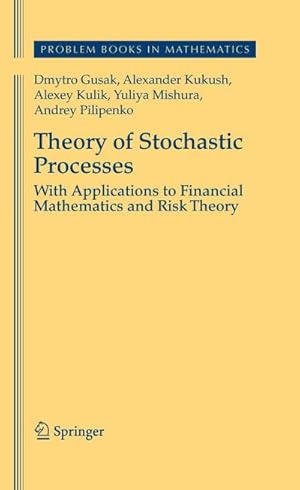Riassunto
Thiscollectionofproblemsisplannedasatextbookforuniversitycoursesinthe theoryofstochasticprocessesandrelatedspecialcourses. Theproblemsinthebook haveawidespectrumofthelevelofdif cultyandcanbeusefulforreaderswith variouslevelsofmasteringinthetheoryofstochasticprocesses. Togetherwithte- nicalandillustrativeproblemsintendedforbeginners,thebookcontainsanumber ofproblemsoftheoreticalnaturethatcanbeusefulforstudentsandundergraduate studentsthatpursueadvancedstudiesinthetheoryofstochasticprocessesandits- plications. Amongothers,theimportantaimofthebookistoprovideateachingstaff anef cienttoolforpreparingseminarstudies,tests,andexamsconcerninguniversity coursesinthetheoryofstochasticprocessesandrelatedtopics. Whilecomposingthe book,theauthorshavepartiallyusedthecollectionsofproblemsinprobabilityt- ory[16,65,75,83]. Also,someexercisesandproblemsfromthemonographsand textbooks[4,9,19,22,82]wereused. Atthesametime,alargepartofourproblem bookcontainsoriginalmaterial. Thebookisorganizedasfollows. Theproblemsarecollectedintochapters,each chapterbeingdevotedtoacertaintopic. Atthebeginningofeachchapter,theth- reticalgroundsforthecorrespondingtopicaregivenbrie ytogetherwiththelistof bibliography,whichthereadercanuseinordertostudythistopicinmoredetail. For themostoftheproblems,eitherhintsorcompletesolutions(oranswers)aregiven, andsomeoftheproblemsareprovidedwithbothhintsandsolutions(answers). H- ever,theauthorsdonotrecommendthatareaderusethehintssystematically,because solvingaproblemwithoutassistanceismuchmoreusefulthanusingaready-made idea. Somestatementsthathaveaparticulartheoreticalinterestareformulatedon theoreticalgrounds,andtheirproofsareformulatedasproblemsforthereader. Such problemsaresuppliedwitheithercompletesolutionsordetailedhints. Inordertoworkwiththeproblembookef ciently,areadershouldbeacquainted withprobabilitytheory,calculus,andmeasuretheorywithinthescopeofresp- tiveuniversity courses. Standard notions, suchas random variable, measurability, independence, Lebesgue measure and integral, and so on are used without ad- tionaldiscussion. Allthenewnotionsandstatementsrequiredforsolvingthepr- lemsaregiveneitherontheoreticalgroundsorintheformulationsoftheproblems vii viii Preface straightforwardly. However,sometimesanotionisusedinthetextbeforeitsformal de nition. Forinstance,theWienerandPoissonprocessesareprocesseswithin- pendentincrementsandthusareformallyintroducedinaTheoreticalgroundsfor Chapter5,buttheseprocessesareusedwidelyintheproblemsofChapters2to4. Theauthorsrecommendthatareaderwhocomestoanunknownnotionorobject usetheIndexinorderto ndthecorrespondingformalde nition. Thesamerec- mendationconcernssomestandardabbreviationsandsymbolslistedattheendofthe book. Someproblemsinthebookformcycles:solutionstooneofthemaregrounded onstatementsofothersoronauxiliaryconstructionsdescribedinsomepreceding solutions. Sometimes,onthecontrary,itisproposedtoprovethesamestatement withindifferentproblemsusingessentiallydifferenttechniques. Theauthorsrec- mendareaderpayspeci cattentiontothesefruitfulinternallinksbetweenvarious topicsofthetheoryofstochasticprocesses. Everypartofthebookwascomposedsubstantiallybyoneauthor. Chapters1-6, and16arecomposedbyA. Kulik,Chapters7,12-15,18,and19byYu. Mishura, Chapters 8-10 by A. Pilipenko, Chapter 17 by A. Kukush, and Chapter 20 by D. Gusak. Chapter11waspreparedjointlybyD. GusakandA. Pilipenko. Atthe sametime,everyauthorhasmadeacontributiontootherpartsofthebookbyprop- ingseparateproblemsorcyclesofproblems,improvingpreliminaryversionsoft- oreticalgrounds,andeditingthe naltext. The authors would like to express their deep gratitude to M. Portenko and A. Ivanovfortheircarefulreadingofapreliminaryversionofthebookandva- ablecommentsthatledtosigni cantimprovementofthetext. Theauthorsarealso gratefultoT. Yakovenko,G. Shevchenko,O. Soloveyko, Yu. Kartashov, Yu. K- menko,A. Malenko,andN. Ryabovafortheirassistanceintranslation,preparing lesandpictures,andcomposingthesubjectindexandreferences. Thetheoryofstochasticprocessesisanextendeddiscipline,andtheauthors- derstandthattheproblembookinitscurrentformmaycausecriticalremarksfrom readers,concerningeitherthestructureofthebookorthecontentofseparatech- ters. Whilepublishingtheproblembookinitscurrentform,theauthorsareopenfor remarks,comments,andpropositions,andexpressinadvancetheirgratitudetoall theircorrespondents. Kyiv DmytroGusak December2008 AlexanderKukush AlexeyKulik YuliyaMishura AndreyPilipenko Contents 1 De?nition of stochastic process. Cylinder?-algebra, ?nite-dimensional distributions, the Kolmogorov theorem...1 Theoreticalgrounds ...1 Bibliography...3 Problems...3 Hints...7 AnswersandSolutions...9 2 Characteristics of a stochastic process. Mean and covariance functions. Characteristic functions...11 Theoreticalgrounds ...11 Bibliography...13 Problems...13 Hints...16 AnswersandSolutions...17 3 Trajectories. Modi?cations. Filtrations...21 Theoreticalgrounds ...21 Bibliography...24 Problems...24 Hints...29 AnswersandSolutions...31 4 Continuity. Differentiability. Integrability...33 Theoreticalgrounds ...33 Bibliography...34 Problems...34 Hints...38 AnswersandSolutions...40 ix x Contents 5 Stochastic processes with independent increments. Wiener and Poisson processes. Poisson point measures...
Dalla quarta di copertina
This book is a collection of exercises covering all the main topics in the modern theory of stochastic processes and its applications, including finance, actuarial mathematics, queuing theory, and risk theory.
The aim of this book is to provide the reader with the theoretical and practical material necessary for deeper understanding of the main topics in the theory of stochastic processes and its related fields.
The book is divided into chapters according to the various topics. Each chapter contains problems, hints, solutions, as well as a self-contained theoretical part which gives all the necessary material for solving the problems. References to the literature are also given.
The exercises have various levels of complexity and vary from simple ones, useful for students studying basic notions and technique, to very advanced ones that reveal some important theoretical facts and constructions.
This book is one of the largest collections of problems in the theory of stochastic processes and its applications. The problems in this book can be useful for undergraduate and graduate students, as well as for specialists in the theory of stochastic processes.
Le informazioni nella sezione "Su questo libro" possono far riferimento a edizioni diverse di questo titolo.
